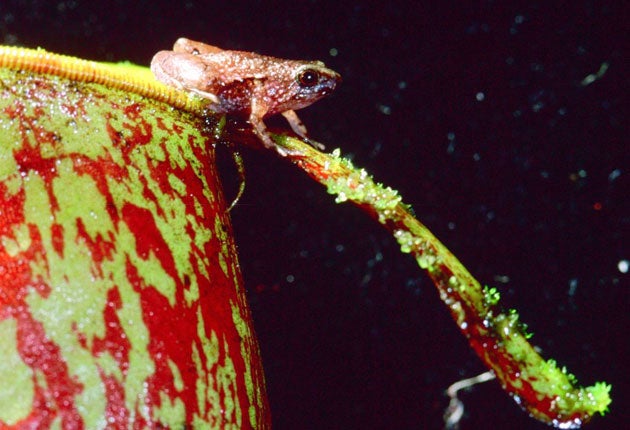Pea-sized frogs found in Borneo carnivorous plants

Your support helps us to tell the story
From reproductive rights to climate change to Big Tech, The Independent is on the ground when the story is developing. Whether it's investigating the financials of Elon Musk's pro-Trump PAC or producing our latest documentary, 'The A Word', which shines a light on the American women fighting for reproductive rights, we know how important it is to parse out the facts from the messaging.
At such a critical moment in US history, we need reporters on the ground. Your donation allows us to keep sending journalists to speak to both sides of the story.
The Independent is trusted by Americans across the entire political spectrum. And unlike many other quality news outlets, we choose not to lock Americans out of our reporting and analysis with paywalls. We believe quality journalism should be available to everyone, paid for by those who can afford it.
Your support makes all the difference.One of the world's tiniest frogs — barely larger than a pea — has been found living in and around carnivorous plants on Borneo island, one of the scientists who made the accidental discovery said today.
Indraneil Das, a scientist at University Malaysia Sarawak, said he and another scientist from Germany were doing field research on frogs in Malaysia's Sarawak state on Borneo island when they chanced on the tiny species on the edge of a road leading to the summit of a mountain in the Kubah National Park in 2006.
"For biologists, this is a curiosity," Das told The Associated Press.
The frogs were named Microhyla nepenthicola after the pitcher plant species where they live, Das said. A Malaysian museum had listed the species but misidentified it as juveniles of another frog species, he said.
The tubular plants are carnivorous, killing insects such as ants, but do not harm the frogs. Tadpoles grow in the liquid inside the plants.
Adult males of the amphibians range in size between 0.42 inches (10.6 millimeters) to 0.5 inches (12.8 millimeters), Das said.
The findings were published by Das and Alexander Haas of the Biozentrum Grindel und Zoologisches Museum of Hamburg, Germany in peer-review journal Zootaxa last week after they completed their research on the frogs.
Das said because the frogs were so small, he and his colleague only found them by tracking their singing of "harsh rasping notes" at dusk. They caught them by making them jump on a white cloth near the pitcher plants.
He added that the discovery should encourage efforts to protect the biological diversity in Borneo's rain forests.
Das said the tiniest known frog found was in Cuba, with its size of at least 0.39 inches (9.8 millimeters).
Join our commenting forum
Join thought-provoking conversations, follow other Independent readers and see their replies
Comments